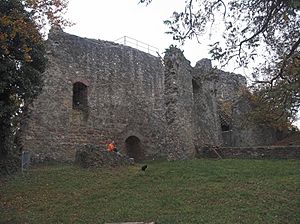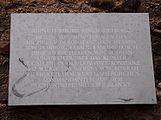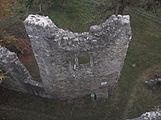Homburg (Stahringen)
| Homburg Castle | ||
|---|---|---|
|
Homburg - View over the inner courtyard towards the shield wall |
||
| Creation time : | around 1000 to 1100 | |
| Castle type : | Höhenburg, spur location | |
| Conservation status: | ruin | |
| Standing position : | Free nobles | |
| Place: | Stahringen | |
| Geographical location | 47 ° 47 '31.3 " N , 8 ° 57' 57.7" E | |
| Height: | 635.3 m above sea level NN | |
|
|
||
The Castle Homburg is the ruin of a high medieval hilltop castle at Stahringen , a district of Radolfzell , and thus is close to the western shore of Lake Constance in Hegau , County Konstanz , Baden-Wurttemberg .
location
At 635.3 m above sea level, above Stahringen, the Homburg served as the seat of the Lords of Homburg for a long time. The castle itself is located on a mountain spur that descends steeply towards the village. Over the centuries the massive castle fell into disrepair like many other Hegau castles and was finally abandoned.
history
The origins of Homburg go back to the 11th century, when the Lords of Homburg, former ministers of the Bishop of Constance, had the curtain wall built on the remains of ice age gravel high above Stahringen. Stahringen was then mentioned for a long time as a knightly village in documents.
During the Swiss War in 1499, the castle was robbed, its residents robbed of their belongings and burned. In 1502 it was rebuilt and enlarged.
In 1565 Wolf von Homburg sold his rule to his son-in-law Hans Konrad von Bodman . He himself died a year later in Radolfzell, with no heirs entitled to inherit, where a bronze epitaph in the cathedral still commemorates him. The Lords of Bodman were local lords in Stahringen for just under 50 years. In 1614 the village and Homburg came to the Benedictine monastery of Sankt Gallen .
During the Thirty Years' War several changes of ownership followed. There were occupations of the castle by both Protestant and Catholic troops. In 1642 the castle was attacked - once again it was the fortress commander from Hohentwiel, Konrad Widerholt - but this time it was burned down. After the war it served as a quarry, remains can be found today in the courtyards below the ruins.
In 1749 the castle - or what was left of the complex - went to the Bishop of Constance . Between 1803 and 1808, Habsburg and Württemberg on the one hand and Baden on the other hand fought over possession of the Stahringen-Homburg rule. After two years of belonging to the Kingdom of Württemberg , the area belonging to the former Landgraviate of Nellenburg was finally assigned to the Grand Duchy of Baden in 1810 and incorporated into the Baden Lake District .
investment
The castle was strategically located only for observation, but due to the flat incline from the west it was easy to take.
Over the centuries, the shield wall up to almost 3 meters thick was clad with large humpback blocks made of Nagelfluh . The Homburg was expanded into a well-fortified residential complex.
Destroyed several times, only an 11 meter high wall and a mighty shield wall give an idea of the size and structural shape.
There are no conclusive reconstructions of the castle. A round tower of the castle can be seen in a painting from the 18th century .
gallery
View over the Untersee to the Alps
literature
- Harald Derschka : Die Ministeriale des Hochstiftes Konstanz ( Konstanz Working Group for Medieval History: Lectures and Research ; Special Volume 45). Thorbecke, Stuttgart 1999, ISBN 3-7995-6755-0 , pp. 40-47;
- Arthur Hauptmann: Castles then and now - castles and castle ruins in southern Baden and neighboring areas . 1st edition, Verlag des Südkurier, Konstanz 1984, ISBN 3-87799-040-1 , pp. 64-66;
- Michael Losse, Hans Noll: Castles, palaces and fortresses in Hegau - fortifications and noble residences in the western Lake Constance area . Michael Greuter Verlag, Hilzingen 2006, ISBN 3-938566-05-1 , p. 128;








